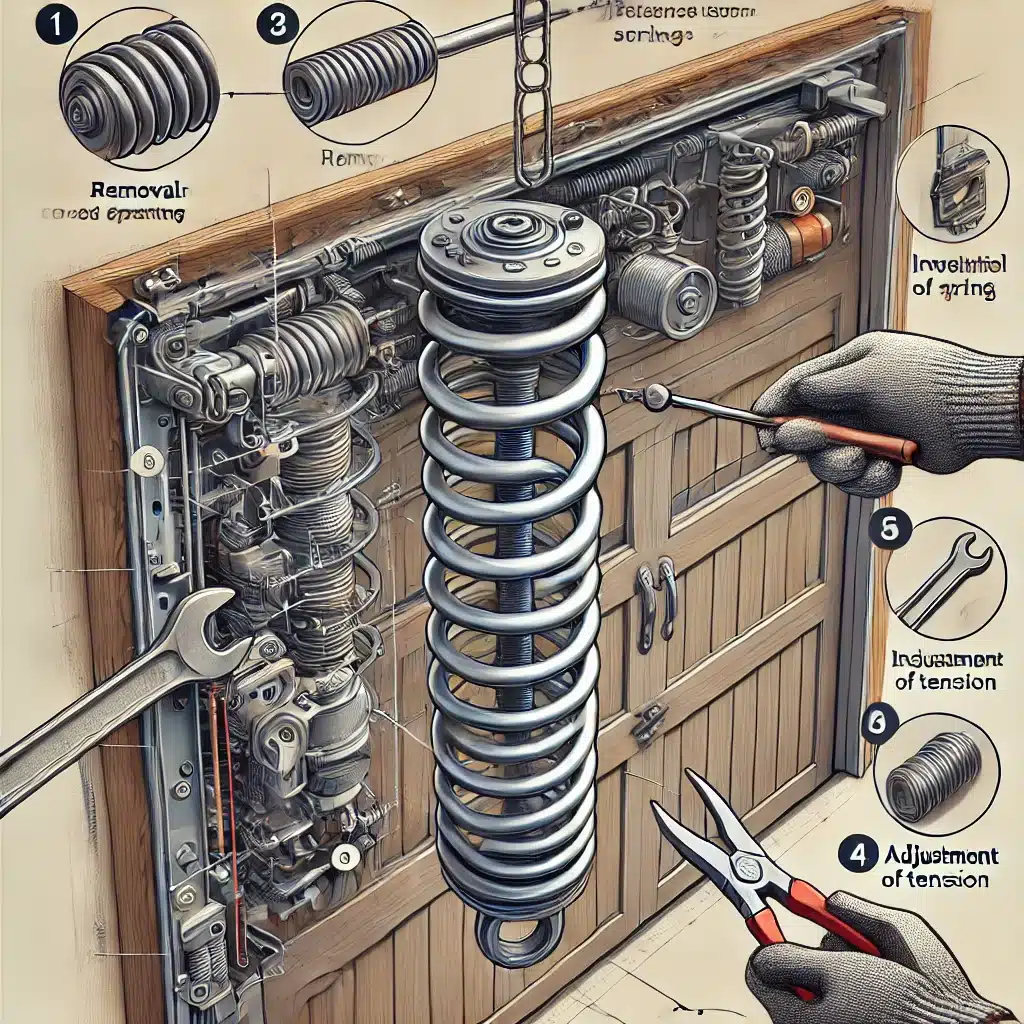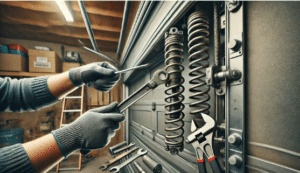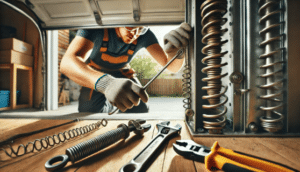Garage door springs play a crucial role in your garage door’s smooth and effortless operation. These coiled mechanisms counterbalance the weight of the door, making it easy to open and close. Manual lifting of the garage door would be extremely difficult without these springs, and the automatic opener would struggle to perform its function. Springs are essential for the convenience they provide and the safety of the door’s operation, ensuring it doesn’t close too quickly or unexpectedly.
Over time, however, these springs can become worn, damaged, or lose their tension, leading to various issues, from difficulty operating the door to potential safety hazards. A worn or broken spring can cause the door to become unbalanced, making it difficult to lift or lower appropriately. In some cases, a failing spring can snap, posing a significant risk of injury or damage to property. Regular inspection and maintenance of these springs are vital to ensure they are in good working condition and to prevent unexpected failures.
This step-by-step guide will walk you through replacing the spring on your garage door. We’ll cover the different types of springs you might encounter, including torsion and extension springs, and provide detailed instructions for safely and effectively replacing them. Understanding the importance of these components and how to maintain them can save you from costly repairs and enhance the longevity and performance of your garage door system. Whether you’re a seasoned DIY enthusiast or a first-time handyman, this guide will equip you with the knowledge and confidence to tackle this essential home maintenance task.
Understanding the Importance of Spring Replacement
Replacing a faulty or worn-out garage door spring is essential for maintaining your garage door system’s proper function and safety. Neglecting to address spring-related issues can result in several problems, including:
- Increased strain on the garage door opener, leading to premature wear and tear
- Potential for the door to slam shut unexpectedly, posing a risk of injury
- Difficulty in manually opening and closing the door, which can be inconvenient and frustrating
Signs That Indicate Your Garage Door Spring Needs Replacement
Recognizing the signs that your garage door spring requires replacement is crucial for addressing the issue before it escalates. Some common indicators include:
- Unbalanced door
If your garage door appears heavier on one side or does not stay open when partially raised, it may indicate a faulty spring.
- Visible wear or damage
Inspect the springs for signs of rust, corrosion, or physical harm, such as cracks or fraying.
- Increased effort to open or close the door
If you notice that it’s becoming increasingly difficult to operate your garage door manually, it could mean the springs have lost their tension.
- Unusual noises
Listen for any squeaking, grinding, or other unusual sounds from the springs, which may indicate a problem.
Safety Precautions Before Starting the Replacement Process
Before attempting to replace the garage door spring, it’s essential to prioritize your safety. Garage door springs are under immense tension and can pose a severe risk of injury if not handled properly. Follow these safety precautions:
- Disconnect the power supply
Unplug the garage door opener or turn off the circuit breaker to prevent the door from being activated during the replacement process.
- Secure the door
Use C-clamps or locking pliers to hold the door in place and prevent it from closing unexpectedly.
- Wear protective gear
Wear safety glasses, gloves, and sturdy shoes to protect yourself from hazards.
- Enlist assistance
Consider having a second person present to help with the replacement process, especially if you’re working with a heavy or difficult-to-manage spring.
Tools and Materials Required for Replacing a Garage Door Spring
To replace a garage door spring, you’ll need the following tools and materials:
- Replacement spring(s) (ensure the new spring(s) match the size and specifications of the existing one(s)
- Winding bars (specialized tools used to wind and unwind the spring safely)
- Pliers or vice grips
- Adjustable wrench
- Lubricant (such as silicone-based garage door lubricant)
- Ladder or step stool (if needed to access the springs)
- Safety glasses and gloves
Step-by-Step Guide on Replacing the Spring on Your Garage Door
-
Prepare the Garage Door
Begin by disconnecting the garage door opener and securing the door in the closed position using C-clamps or locking pliers.
-
Identify the Spring Type
Determine whether your garage door has a torsion or extension spring. The replacement process will vary depending on the spring type.
-
Release the Tension
Use the winding bars carefully to release the spring tension for torsion springs. For extension springs, unhook the springs from the door and the wall.
-
Remove the Old Spring
Carefully remove the old spring, noting its position and orientation to ensure the proper installation of the new spring.
-
Install the New Spring
Follow the manufacturer’s instructions to install the new spring properly. This may involve winding the torsion spring or hooking the extension springs to the appropriate attachment points.
-
Adjust the Spring Tension
Carefully adjust the spring tension to ensure the door is appropriately balanced and easy to operate. This may require multiple adjustments.
-
Reconnect the Garage Door
Reattach the garage door to the opener and ensure all components are correctly connected and functioning.
-
Test the Door Operation
Manually open and close the garage door several times to ensure smooth, effortless operation.
-
Apply Lubricant
Apply a thin coat of silicone-based lubricant to the spring and other moving parts to promote long-term performance and prevent rust or corrosion.
-
Dispose of the Old Spring Properly
Safely dispose of it, as it can be hazardous if not handled correctly.
Common Mistakes to Avoid During Spring Replacement
To ensure a successful and safe garage door spring replacement, it’s essential to be aware of and avoid the following common mistakes:
- Failing to Secure the Door Properly
Refrain from securing the door with C-clamps or locking pliers to prevent it from closing unexpectedly, which can be extremely dangerous.
- Incorrect Spring Replacement
Using the proper size or type of replacement spring can lead to appropriate door balance and potential safety issues.
- Improper Winding or Unwinding
Incorrectly winding or unwinding the spring can cause it to snap, potentially causing injury or damage.
- Lack of Proper Tools
Attempting to replace the spring without the necessary tools, such as winding bars, can make the process much more complex and increase the risk of injury.
- Overlooking Safety Precautions
Disregarding safety measures, such as wearing protective gear or having a second person assist, can put you at risk of harm.
- Improper Disposal of Old Springs
Improperly disposing of the old spring can be hazardous, as the coiled tension can still pose a risk.
Testing and Adjusting the Garage Door After Spring Replacement
After completing the spring replacement, it’s essential to thoroughly test the garage door’s operation and make any necessary adjustments to ensure it’s functioning correctly and safely.
- Test the Door Operation
Manually open and close the garage door several times, paying attention to the door’s balance, smoothness, and ease of movement. Ensure the door stays open when partially raised and closes completely without slamming.
- Adjust the Spring Tension
If the door is not balanced correctly, you may need to adjust the spring tension further. Carefully follow the manufacturer’s instructions to make any necessary adjustments.
- Check the Garage Door Opener
Reconnect the garage door opener and test its functionality, ensuring it opens and closes smoothly and stops at the appropriate positions.
- Lubricate Moving Parts
Apply a thin silicone-based lubricant to the springs, pulleys, and other moving parts to maintain smooth operation and prevent rust or corrosion.
- Perform a Safety Check
Ensure the door’s safety features, such as the auto-reverse mechanism, function correctly. Test the safety sensors by placing an object in the door’s path to verify the door reverses as expected.
Tips for Maintaining the Longevity of Your Garage Door Springs
To prolong the lifespan of your garage door springs and prevent the need for frequent replacements, consider the following maintenance tips:
- Regular Lubrication
To reduce friction and prevent rust, apply a silicone-based lubricant to the springs, pulleys, and other moving parts every 6-12 months.
- Balanced Door Maintenance
Adjust the spring tension to ensure your garage door remains adequately balanced. This will reduce the strain on the springs and other components.
- Avoid Excessive Usage
Limit the times you open and close your garage door daily to minimize wear and tear on the springs.
- Professional Inspections
Schedule annual or bi-annual inspections with a qualified garage door technician to identify potential issues and perform necessary maintenance.
- Prompt Repair of Damaged Components
Address any issues, such as a broken or worn spring, as soon as they arise to prevent further damage and ensure the continued safe operation of your garage door.
FAQs
Can you replace the garage door springs yourself?
You can replace garage door springs yourself if you have the appropriate tools and knowledge and take the necessary safety precautions. Still, it is essential to understand that this task can be dangerous due to the high spring tension. Garage door springs are under significant stress, and mishandling them can result in serious injury. Following a detailed guide can make the process manageable for those who are confident in their DIY skills and have experience with similar tasks. However, many homeowners prefer to hire a professional to ensure the job is done safely and correctly, minimizing the risk of accidents and damage.
Is replacing a garage door spring hard?
Replacing a garage door spring is considered challenging, especially for individuals who are not experienced with home garage door repairs. The difficulty arises from the need to handle high-tension springs safely, which requires specific tools and a precise method to avoid injury. Additionally, understanding the type of spring system your garage door uses, whether torsion or extension, adds to the complexity. While a skilled DIYer can perform the replacement, most people find relying on professional services safer and more efficient to ensure the job is done correctly.
How do I open my garage door if the spring is broken?
If your garage door spring is broken, you can open it manually, but it will be heavy and difficult to lift, so getting help is advisable. First, ensure the garage door opener is disconnected to prevent accidental activation. Then, you must carefully lift the door from the bottom, using your legs to avoid straining your back. Once the door is open, secure it with a clamp or prop to prevent it from closing unexpectedly. This is a temporary solution, and you should arrange for the spring to be replaced as soon as possible to restore regular operation.
How long does it take to replace a garage door spring?
Replacing a garage door spring generally takes one to two hours for a professional, including the time needed to safely release the tension from the old spring, remove it, install the new spring, and test the door’s operation. For a DIYer, the process could take longer, especially if it’s their first time performing such a task. Proper preparation, careful handling, and ensuring all safety measures are followed can extend the time required. Allowing extra time for unforeseen difficulties is prudent, especially for those unfamiliar with the task.
How to tell if garage door springs need to be replaced?
You can tell if garage door springs need to be replaced by observing signs such as the door becoming challenging to open or close, visible gaps or wear in the springs, unusual noises during operation, or the door appearing unbalanced or crooked. If the door falls quickly when closing or does not stay open, these are clear indicators that the springs may be worn out. Regular maintenance checks can help identify these issues early. Additionally, if you notice the garage door opener struggling or making more noise than usual, the springs are losing their tension and need replacement.
Should I replace both garage door springs at the same time?
Yes, replacing both garage door springs at the same time is generally recommended, even if only one appears to be damaged or broken. This is because both springs typically have undergone the same amount of wear and tear, and if one spring fails, the other is likely close behind. Replacing both springs simultaneously ensures balanced operation and reduces the risk of dealing with another spring failure shortly after. It also ensures that the door remains appropriately balanced, which is crucial for the smooth and safe operation of the garage door system.
Conclusion
Replacing a garage door spring is a critical maintenance task that can seem daunting, but it is entirely manageable with the proper guidance and tools. At Perfect Solutions Garage Door, we are committed to helping you maintain the safety and functionality of your garage door system. Our detailed guide ensures you understand every step of the process, from identifying the type of spring to safely installing the new one. By following our expert advice, you can handle this task confidently, ensuring your new garage door operates smoothly and securely.
Choosing Perfect Solutions Garage Door means choosing reliability, expertise, and peace of mind. We offer comprehensive services beyond just guiding you through DIY projects; we are here to provide professional assistance whenever needed. Our team of skilled technicians is ready to step in if you prefer a professional touch or encounter any challenges during the process. We understand the intricacies of garage door systems and are dedicated to delivering top-notch service that keeps your door functioning optimally for years to come.
Don’t let a broken spring disrupt your daily routine. Contact Perfect Solutions Garage Door today to schedule a service or consultation. Let our experts handle the complexities of garage door maintenance, ensuring your door is safe, reliable, and efficient. Whether you need immediate repairs, regular maintenance, or expert advice, Perfect Solutions Garage Door is your trusted partner for all garage door needs. Embrace the confidence of a well-maintained garage door and enjoy the convenience and security it brings to your home.
End Note
Thank you for reading our guide on replacing the spring on your garage door. At Perfect Solutions Garage Door, we are dedicated to providing you with the best resources and services to ensure your garage door operates smoothly and safely. Visit our service areas page for more information about our extensive service areas and to see how we can assist you.
Explore our website to discover our wide range of garage door services, from repairs to new installations. Our gallery showcases recent projects, highlighting our commitment to quality and excellence. If you’re curious about the brands we work with, check out our garage door brands page for more details.
Learn more about our story and team on the About Us page. If you have any questions or need immediate assistance, please contact us. We are here to help you with all your garage door needs and ensure you receive the best possible service.
Visit our blog to stay updated with the latest tips and news. Thank you for choosing Perfect Solutions Garage Door, where your satisfaction and the safety of your garage door system are our top priorities. We look forward to serving you and making your home a safer, more convenient place.





